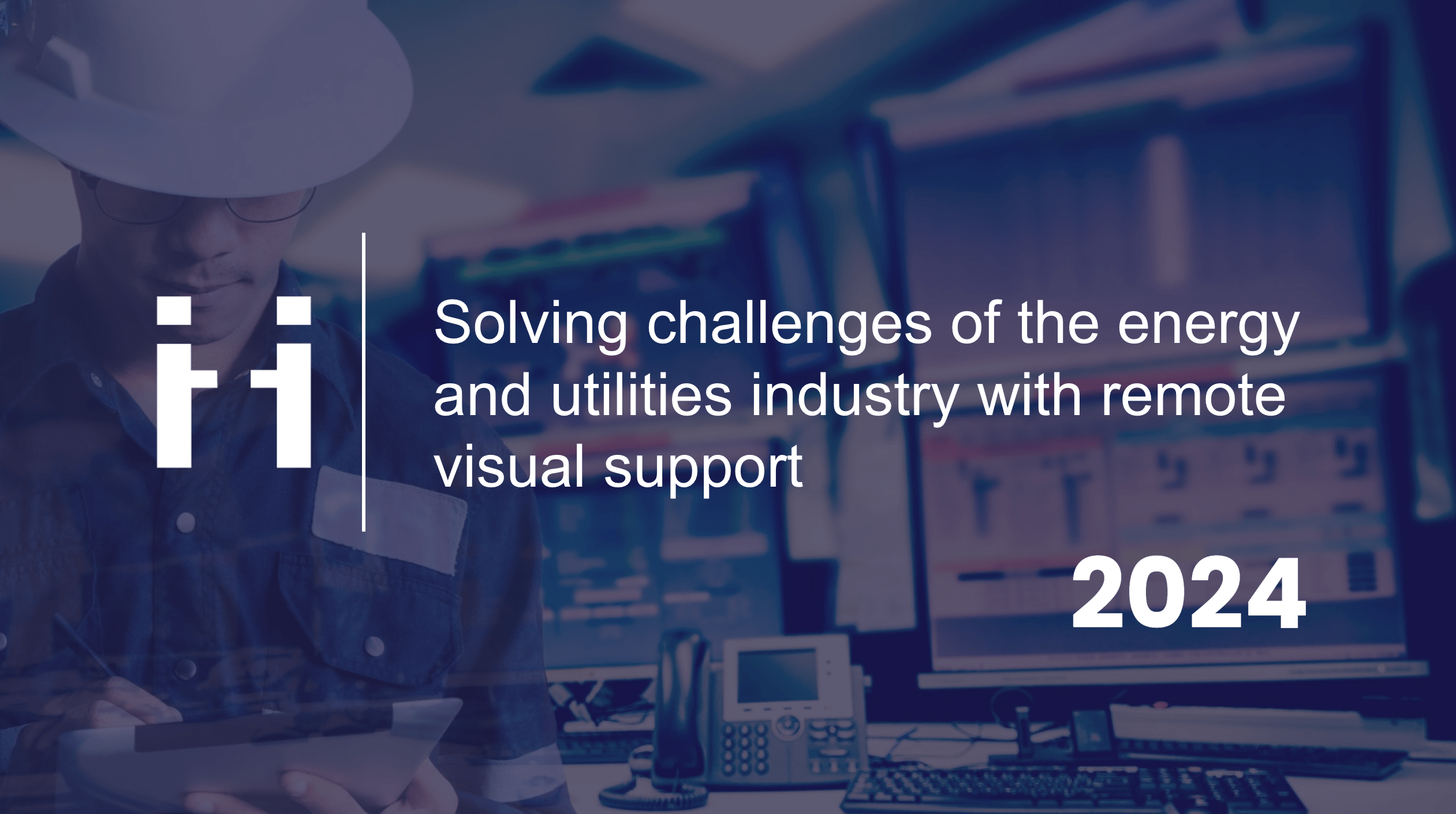
Share this article
Share this article

The energy and utilities sector encompasses a broad array of operations, which involve activities such as delivering natural gas and water services through transmission, distribution, retailing, and maintenance processes. It plays a crucial role in supporting economic activities, manufacturing, transportation, healthcare, education, and other sectors that rely heavily on energy and utilities for operations. Although it remains a cornerstone of our lives, the energy and utilities industry is not immune to challenges. This article will break down the problems of the energy and utilities industry and how modern technologies such as remote visual support and field service management software can help tackle them.
Energy and utilities companies are perplexed by the wide array of questions depending on the activities they deliver. Nevertheless, they are united by the main concern: how can they adapt to serve customers in the rapidly changing world?
Many companies still rely on outdated ways of handling work orders. Cumbersome paperwork, Excel spreadsheets to track installation and maintenance, phone calls to collect customer queries, paper maps to build routes for technicians… the list goes on. While it may seem that digitalization has taken the world way beyond these means, for energy and utility companies the situation does not evolve so quickly due to the complexity of the sector.
Time wasted on handling the work orders in an old-fashioned way is not the only expense at stake. The risk of losing data and no real visibility on the state of the assets and short and long-term operations are much more serious consequences.
With the rapidly developing grid, it has become clear that connected devices and data must be incorporated into the utility companies’ systems. The 5th generation of mobile communication technology can support an impressive number of connected devices and transmit a plethora of data. Thanks to it, companies can move data to the cloud and extract more in-depth insights. However, due to the slow adaptability of the industry, it is far too early for the energy and utilities sector to benefit from these capabilities to the fullest. There is a great mismatch between the actual state of affairs and the technological potential, and it may take years for this gap to close.
Nevertheless, gradually, the market will force utility companies to adopt new infrastructure that would take into account disruptive technologies, aging asset performance with increased expectations of reliability, and increased pressure on operational efficiency and workforce productivity. It is only a matter of time. Those companies that figure it out early will be ahead of the competition.
Environmental commitments have found their reflection in the strategies of many energy and utility companies as senior management started to recognize them for value creation and environmental, social, and governance roles. This is a long way to go from resource-extracting activities becoming oriented toward renewable energy to maintenance operations switching to paperless methods.
The challenge is to go “greener” without losing reliability and affordability which sometimes contradict each other. Surveys report that such drastic changes also require the internal cultural transformation of energy and utility companies.
Despite this, industry experts predict that in the coming years more and more companies will embark on the decarbonization journey, and governmental regulations on this matter will become clearer.
In areas with turbulent weather conditions or in areas that are difficult to reach, the maintenance of the assets of energy and utility companies can be a pressing issue. Disrupted internet connectivity, different time zones, and the lack of qualified staff on-site are only the tip of the iceberg of problems they have to deal with. Meanwhile, the US interagency report warns that climate change will lead to worsening weather conditions and more power outages and disruptions. This will lead to a decreased quality of life in the areas that are difficult to reach unless there is a technology that allows remote maintenance.
If the company does not have a digital solution that allows remote diagnostic without displacement of the expert in its product suite, it has no visibility on its assets and equipment in case of a force major. The absence of a timely response to a malfunction may lead to a total collapse of the system and long-term, costly consequences.
Although changes require time and resources, it does not mean that the companies cannot already take steps and implement digital solutions that can facilitate their operations. This is where remote visual support and field service management software come into play.
The problem of incomplete information about the encountered malfunction is an acute issue for many energy and utilities companies. Phones and emails are difficult to use in mobility, they do not support heavy media files, and the support agents are often overwhelmed with tickets and cannot provide a timely response.
Remote visual support allows the launching of a real-time video call that permits the support agent in the office to see the problem with his own eyes, hear the troubling sounds, and add annotations regarding particular moments. When the session is over, the dedicated archive with the recording of it is saved inside the work order.
What if the expert is not available?
The technician on-site can report the problem asynchronously. Suppose there is an issue with a liquefied petroleum gas (LPG) tank. With such a remote visual support tool like ViiBE, the customer can start a unilateral stream. He records the problem by himself, takes screenshots, uses collaborative tools such as arrows and forms to highlight troubled areas of the tank, leaves comments for the support expert from the utility company, and sends them to him for assistance.
The expert will receive this report in the automatically created work order. Then he can trigger a real-time video call inside the same work order. If the issue is too complex, he can share access to it with his teammates for additional expertise.
The risk of lost data is eliminated, the customer receives a timely response that prevents the situation from worsening, and the company gets full visibility of the problems which allows it to improve its products and services.
Based on the obtained information, the right technician can be dispatched on-site. The company no longer needs to deal with unprepared visits and wasted resources affiliated with unnecessary displacement.
Field technicians often work in diverse and remote locations. Having easy access to work orders with video archives through mobile devices ensures they can instantly retrieve critical information about tasks, customer requirements, equipment details, and safety protocols while on-site. Clear visibility of historical maintenance records, equipment specifications, service histories, and any previous issues reported can significantly speed up the resolution of the new issue. This wealth of information empowers technicians to make informed decisions and perform tasks more effectively.
Both a remote visual support solution and field service management software are cloud-based. They offer scalability, allowing companies to adjust resources as needed. This flexibility accommodates the fluctuating demands of utility operations without the need for extensive infrastructure investments.
The remote visual support’s seamless integration into field service management software is possible thanks to WebSDK, a customized integration kit. Visual support functionalities become available in the familiar interface of the remote visual support tool. Therefore, users do not need to work in multiple tabs and change solutions – everything is accessible in one place.
Last but not least, cloud-based platforms like this enable the centralization of data, allowing for better data management and analytics. Companies can gather valuable insights from operational data, improving decision-making and optimizing processes for better efficiency.
Usually the more complex the industry, the more cumbersome issue resolution is. Customers have to get accustomed to long response times, wordy explanations, and time-consuming maintenance processes.
By leveraging remote visual support integrated into field service management solutions, field technicians can establish instant connections with remote experts or support teams, enabling real-time visual assessments and guidance during service calls. This immediate access to expertise facilitates quicker issue resolution, reducing downtime and ensuring faster restoration of essential services for customers. Additionally, the visual aspect allows experts to communicate more effectively, providing clearer explanations and demonstrating the steps taken to address the problem. Customers appreciate the transparency and speed at which their issues are resolved, leading to increased satisfaction levels. The ability to visually demonstrate the resolution process instills confidence in customers, fostering trust in the company’s ability to efficiently and effectively handle their service needs.
The energy and utilities industry, a vital support system for essential services and economic activities, faces various challenges from outdated work order management to adapting to new technologies and environmental commitments. Amidst these hurdles, modern solutions like remote visual support and field service management software emerge as transformative tools.
Thanks to them, it becomes possible to speed up resolutions of the issues by enabling remote qualification either via real-time video calls or asynchronous reporting. Moreover, they grant easy mobile access to critical data, empowering field technicians and fostering the notion of knowledge and expertise sharing.
Seamlessly integrated and cloud-based, these solutions not only modernize operations but also enhance customer satisfaction by ensuring transparent and efficient issue resolution, showcasing the industry’s adaptability and efficiency in meeting evolving demands.